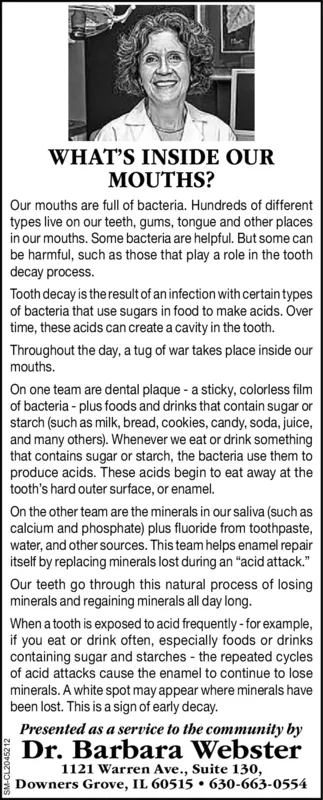Advertisement

-
Published Date
January 11, 2023This ad was originally published on this date and may contain an offer that is no longer valid. To learn more about this business and its most recent offers, click here.
Ad Text
WHAT'S INSIDE OUR MOUTHS? Our mouths are full of bacteria. Hundreds of different types live on our teeth, gums, tongue and other places in our mouths. Some bacteria are helpful. But some can be harmful, such as those that play a role in the tooth decay process. Tooth decay is the result of an infection with certain types of bacteria that use sugars in food to make acids. Over time, these acids can create a cavity in the tooth. Throughout the day, a tug of war takes place inside our mouths. On one team are dental plaque - a sticky, colorless film of bacteria-plus foods and drinks that contain sugar or starch (such as milk, bread, cookies, candy, soda, juice, and many others). Whenever we eat or drink something that contains sugar or starch, the bacteria use them to produce acids. These acids begin to eat away at the tooth's hard outer surface, or enamel. On the other team are the minerals in our saliva (such as calcium and phosphate) plus fluoride from toothpaste, water, and other sources. This team helps enamel repair itself by replacing minerals lost during an "acid attack." Our teeth go through this natural process of losing minerals and regaining minerals all day long. When a tooth is exposed to acid frequently-for example, if you eat or drink often, especially foods or drinks containing sugar and starches - the repeated cycles of acid attacks cause the enamel to continue to lose minerals. A white spot may appear where minerals have been lost. This is a sign of early decay. SM-CL2045212 Presented as a service to the community by Dr. Barbara Webster 1121 Warren Ave., Suite 130, Downers Grove, IL 60515 630-663-0554 WHAT'S INSIDE OUR MOUTHS ? Our mouths are full of bacteria . Hundreds of different types live on our teeth , gums , tongue and other places in our mouths . Some bacteria are helpful . But some can be harmful , such as those that play a role in the tooth decay process . Tooth decay is the result of an infection with certain types of bacteria that use sugars in food to make acids . Over time , these acids can create a cavity in the tooth . Throughout the day , a tug of war takes place inside our mouths . On one team are dental plaque - a sticky , colorless film of bacteria - plus foods and drinks that contain sugar or starch ( such as milk , bread , cookies , candy , soda , juice , and many others ) . Whenever we eat or drink something that contains sugar or starch , the bacteria use them to produce acids . These acids begin to eat away at the tooth's hard outer surface , or enamel . On the other team are the minerals in our saliva ( such as calcium and phosphate ) plus fluoride from toothpaste , water , and other sources . This team helps enamel repair itself by replacing minerals lost during an " acid attack . " Our teeth go through this natural process of losing minerals and regaining minerals all day long . When a tooth is exposed to acid frequently - for example , if you eat or drink often , especially foods or drinks containing sugar and starches - the repeated cycles of acid attacks cause the enamel to continue to lose minerals . A white spot may appear where minerals have been lost . This is a sign of early decay . SM - CL2045212 Presented as a service to the community by Dr. Barbara Webster 1121 Warren Ave. , Suite 130 , Downers Grove , IL 60515 630-663-0554
